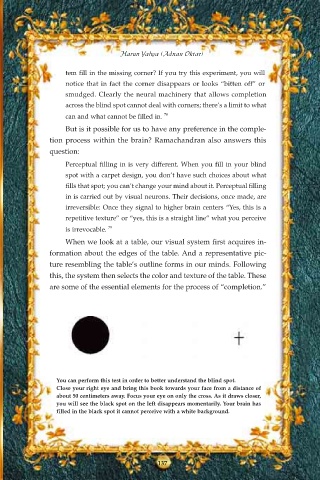Page 139 - Darwin's Dilemma: The Soul
P. 139
Harun Yahya (Adnan Oktar)
tem fill in the missing corner? If you try this experiment, you will
notice that in fact the corner disappears or looks “bitten off” or
smudged. Clearly the neural machinery that allows completion
across the blind spot cannot deal with corners; there’s a limit to what
can and what cannot be filled in. 78
But is it possible for us to have any preference in the comple-
tion process within the brain? Ramachandran also answers this
question:
Perceptual filling in is very different. When you fill in your blind
spot with a carpet design, you don’t have such choices about what
fills that spot; you can’t change your mind about it. Perceptual filling
in is carried out by visual neurons. Their decisions, once made, are
irreversible: Once they signal to higher brain centers “Yes, this is a
repetitive texture” or “yes, this is a straight line” what you perceive
is irrevocable. 79
When we look at a table, our visual system first acquires in-
formation about the edges of the table. And a representative pic-
ture resembling the table’s outline forms in our minds. Following
this, the system then selects the color and texture of the table. These
are some of the essential elements for the process of “completion.”
You can perform this test in order to better understand the blind spot.
Close your right eye and bring this book towards your face from a distance of
about 50 centimeters away. Focus your eye on only the cross. As it draws closer,
you will see the black spot on the left disappears momentarily. Your brain has
filled in the black spot it cannot perceive with a white background.
137

